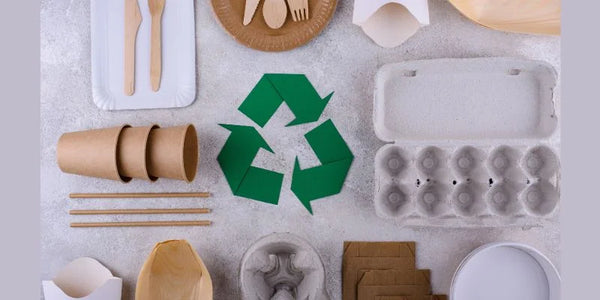
In a world that is increasingly conscious of its environmental impact, businesses are being called upon to take responsibility for their actions. One area where companies can make a significant difference is in their packaging choices.
Sustainable packaging is no longer just a trend
It has become an essential aspect of business operations. Not only does it help reduce waste and conserve resources, but it also aligns businesses with the values of their environmentally-conscious customers.
In this article, we will explore the reasons why sustainable packaging is crucial for businesses today. We will delve into the environmental benefits, the positive impact on brand image, and the potential for cost savings.
By understanding the importance of sustainable packaging, businesses can take a proactive approach towards minimizing their ecological footprint while also enhancing their bottom line. So, let's dive in and discover why going green is not just an option but a necessity in today's business landscape.

The Importance of Sustainable Packaging
Sustainable packaging goes beyond simply using materials that are recyclable or biodegradable. It encompasses the entire life cycle of a product's packaging, from design to disposal. By adopting sustainable packaging practices, businesses can reduce their environmental impact and contribute to a more sustainable future.
Environmental Benefits
One of the primary reasons why sustainable packaging is essential for businesses is its positive impact on the environment. Traditional packaging methods often involve the use of materials that are non-renewable, such as plastic and Styrofoam. These materials take hundreds of years to decompose and contribute to pollution and waste.
On the other hand, sustainable packaging focuses on using renewable and recyclable materials, reducing the amount of waste that ends up in landfills. By choosing sustainable packaging, businesses can help conserve natural resources and minimize their carbon footprint.
Positive Brand Image
In today's socially conscious world, consumers are increasingly making purchasing decisions based on a company's environmental practices. By adopting sustainable packaging, businesses can differentiate themselves from their competitors and attract environmentally-conscious customers.
Sustainable packaging sends a powerful message that a business is committed to reducing its impact on the environment and is actively working towards a more sustainable future. This can lead to increased customer loyalty and brand advocacy, ultimately driving business growth.
Cost Savings
Contrary to popular belief, sustainable packaging doesn't have to come at a higher cost. In fact, it can lead to significant cost savings in the long run. By choosing materials that are lightweight and require less energy to produce, businesses can reduce their packaging costs.
Additionally, sustainable packaging often has a longer shelf life, reducing the need for frequent replenishment. Moreover, businesses can also benefit from government incentives and tax credits for adopting sustainable practices. By considering the total cost of ownership, businesses can realize the financial advantages of sustainable packaging.

Environmental Impact of Traditional Packaging
To fully understand the importance of sustainable packaging, it's crucial to examine the environmental impact of traditional packaging methods. Traditional packaging, such as plastic and Styrofoam, has numerous negative consequences for the environment.
1. Non-Renewable Materials
Traditional packaging often relies on non-renewable materials, such as petroleum-based plastics. These materials are derived from fossil fuels and take a significant toll on the environment. Extracting and processing fossil fuels contribute to air and water pollution, habitat destruction, and climate change. By transitioning to sustainable packaging, businesses can reduce their dependence on non-renewable resources and contribute to a more sustainable future.
2. Pollution and Waste
Traditional packaging materials, such as plastic, have a devastating impact on the environment. Plastic waste often ends up in landfills or oceans, where it takes hundreds of years to decompose. This leads to pollution of waterways and harm to marine life. Additionally, the production of plastic packaging involves the release of harmful greenhouse gases, contributing to climate change. Sustainable packaging aims to minimize waste and pollution by using materials that are recyclable, biodegradable, and compostable.
3. Energy Consumption
The production of traditional packaging materials requires significant amounts of energy. This energy consumption contributes to greenhouse gas emissions and exacerbates climate change. Sustainable packaging focuses on using materials that require less energy to produce, reducing the carbon footprint associated with packaging manufacturing. By adopting sustainable packaging practices, businesses can contribute to the global effort to reduce energy consumption and combat climate change.
Trends in Sustainable Packaging
As businesses recognize the importance of sustainable packaging, the industry is evolving to meet the growing demand for eco-friendly solutions. Several trends have emerged in the sustainable packaging space, driving innovation and paving the way for a more sustainable future.
Minimalism and Simplification
One of the prominent trends in sustainable packaging is minimalism and simplification. Many businesses are opting for minimalist packaging designs that use fewer materials and reduce waste. By eliminating unnecessary packaging components, such as excess layers or inserts, businesses can minimize their environmental impact while still delivering a quality product to customers.
Biodegradable and Compostable Materials
Another trend in sustainable packaging is the use of biodegradable and compostable materials. These materials are designed to break down naturally in the environment, reducing the amount of waste that ends up in landfills. Biodegradable packaging materials, such as plant-based plastics and bio-based polymers, offer a more sustainable alternative to traditional packaging materials. Compostable packaging takes sustainability a step further, as it can be safely composted along with organic waste, resulting in nutrient-rich soil.
Innovative Packaging Designs
Innovation plays a crucial role in sustainable packaging. Businesses are exploring new packaging designs and materials that are both eco-friendly and functional. For example, there has been a rise in the use of renewable and biodegradable alternatives to plastic, such as mushroom-based packaging and seaweed-based packaging. These innovative materials offer similar protective properties as traditional packaging materials but have a significantly lower environmental impact.

Choosing Sustainable Packaging Materials
When it comes to sustainable packaging, choosing the right materials is key. There are several factors to consider when selecting sustainable packaging materials, including recyclability, biodegradability, and renewable resources.
1. Recyclability
Recyclability is a fundamental characteristic of sustainable packaging materials. Opting for materials that can be easily recycled, such as paper, cardboard, glass, and certain types of plastic, ensures that the packaging can be reused and repurposed, reducing the need for virgin materials. It's important to consider the local recycling infrastructure and educate consumers on proper recycling practices to maximize the recyclability of packaging materials.
2. Biodegradability
Biodegradable packaging materials break down naturally in the environment, reducing the amount of waste that ends up in landfills. Materials such as plant-based plastics, bio-based polymers, and compostable packaging offer a more sustainable alternative to non-biodegradable materials. However, it's crucial to ensure that these materials are certified as biodegradable and compostable, as not all materials marketed as such meet the necessary standards.
3. Renewable Resources
Choosing packaging materials derived from renewable resources is another essential aspect of sustainable packaging. Renewable resources, such as bamboo, sugarcane, and cornstarch, can be replenished quickly, reducing the strain on natural resources. These materials offer a more sustainable alternative to non-renewable resources, such as petroleum-based plastics. By opting for packaging materials derived from renewable resources, businesses can minimize their environmental impact and contribute to a more sustainable future.
Designing Sustainable Packaging
In addition to choosing the right materials, designing sustainable packaging is crucial for minimizing environmental impact and enhancing brand image. Sustainable packaging design takes into account the entire life cycle of the packaging, from production to disposal.
1. Right-sizing and Lightweight
Right-sizing and lightweight packaging can significantly reduce material usage and transportation costs. By designing packaging that is just the right size for the product, businesses can minimize the amount of excess materials used. Additionally, lightweight packaging reduces energy consumption during transportation and lowers shipping costs. It's important to strike a balance between protecting the product and minimizing packaging waste.
2. Reusability and Multi-functionality
Designing packaging with reusability and multi-functionality in mind encourages customers to keep and repurpose the packaging rather than throwing it away. For example, using packaging that can be easily transformed into storage containers or decorative items extends the lifespan of the packaging and reduces waste. By providing customers with creative ideas for repurposing the packaging, businesses can enhance the overall customer experience and promote sustainable practices.
3. Sustainable Printing and Labeling
In sustainable packaging design, it's essential to consider the printing and labeling processes. Using eco-friendly inks and adhesives that are free from harmful chemicals reduces environmental impact. Additionally, opting for minimalistic and informative labeling designs can reduce the amount of ink and paper used, further minimizing waste. By incorporating sustainable printing and labeling practices, businesses can align their packaging design with their commitment to sustainability.

Cost Considerations of Sustainable Packaging
Contrary to popular belief, sustainable packaging doesn't have to come at a higher cost. In fact, it can lead to significant cost savings in the long run. By considering the total cost of ownership, businesses can make informed decisions about sustainable packaging and realize the financial advantages.
Material Costs
While some sustainable packaging materials may have a higher upfront cost than their traditional counterparts, they can often offer long-term cost savings. For example, investing in biodegradable packaging materials may initially be more expensive, but it can lead to reduced waste disposal costs and potential tax incentives. Additionally, lightweight packaging materials can lower transportation costs, as they require less fuel for shipping.
Operational Efficiency
Sustainable packaging can also improve operational efficiency, leading to cost savings. For example, right-sizing packaging reduces the amount of material required, resulting in lower production costs. Additionally, sustainable packaging designs that are easier to handle and assemble can reduce labor costs. By streamlining packaging processes and optimizing efficiency, businesses can realize cost savings while maintaining their commitment to sustainability.
Customer Perception and Loyalty
The positive perception of sustainable packaging among customers can have a significant impact on a business's bottom line. Customers are increasingly willing to pay a premium for products packaged in an environmentally-friendly manner. By adopting sustainable packaging, businesses can attract environmentally-conscious customers and build brand loyalty. This loyalty can lead to increased sales and higher customer retention rates, ultimately benefiting the business financially.

Marketing and Branding Opportunities with Sustainable Packaging
Sustainable packaging offers significant marketing and branding opportunities for businesses. By incorporating sustainability into their packaging design and messaging, businesses can differentiate themselves from their competitors and attract environmentally-conscious consumers.
Eco-friendly Branding
Adopting sustainable packaging allows businesses to position themselves as eco-friendly brands. Incorporating eco-friendly symbols, such as recycling logos or certifications, on packaging communicates a commitment to sustainability. Additionally, using messaging that emphasizes the use of renewable materials or reduced environmental impact can resonate with environmentally-conscious consumers. By aligning their branding with sustainable packaging, businesses can create a positive brand image and attract like-minded customers.
Transparent Communication
Transparent communication about sustainable packaging practices can further enhance a business's brand image. Providing information about the materials used, the manufacturing processes, and the environmental benefits of the packaging demonstrates a commitment to transparency and accountability. Customers appreciate businesses that are open and honest about their sustainability efforts, fostering trust and loyalty.
Social Media and Influencer Marketing
Sustainable packaging can be a powerful marketing tool on social media platforms. Sharing behind-the-scenes content about sustainable packaging initiatives, showcasing eco-friendly packaging designs, and highlighting the positive environmental impact can generate buzz and engage customers. Collaborating with influencers and thought leaders in the sustainability space can also amplify the reach and impact of sustainable packaging messaging.

The Future of Sustainable Packaging
As businesses and consumers continue to prioritize sustainability, the future of sustainable packaging looks promising. Innovations in materials, design, and manufacturing processes are driving the development of even more eco-friendly packaging solutions.
Material Innovations
Researchers and entrepreneurs are continuously exploring new materials that offer sustainable alternatives to traditional packaging. From plant-based plastics to biodegradable polymers, the range of materials available for sustainable packaging is expanding. Additionally, advancements in recycling technologies are making it possible to recycle a wider range of materials, further reducing waste and promoting a circular economy.
Circular Economy
The concept of a circular economy, where resources are kept in use for as long as possible, is gaining traction in the packaging industry. By designing packaging that can be easily reused, recycled, or composted, businesses can contribute to a more sustainable and efficient system. The adoption of reusable packaging models, like the Loop platform mentioned earlier, is a step in the direction of a circular economy.
Consumer Education and Awareness
As consumers become more educated and aware of the environmental impact of packaging, they are demanding more sustainable options. Businesses that invest in consumer education and awareness campaigns about the importance of sustainable packaging can build stronger relationships with their customers. By providing information about recycling practices, sustainable materials, and the benefits of eco-friendly packaging, businesses can empower consumers to make more informed choices.
Final Thoughts:
Sustainable packaging is no longer just a nice-to-have for businesses; it has become an essential aspect of operations. By choosing sustainable packaging materials, designing eco-friendly packaging, and communicating transparently with customers, businesses can align themselves with the values of their environmentally-conscious consumers. Sustainable packaging offers numerous benefits, from reducing waste to saving the planet.



